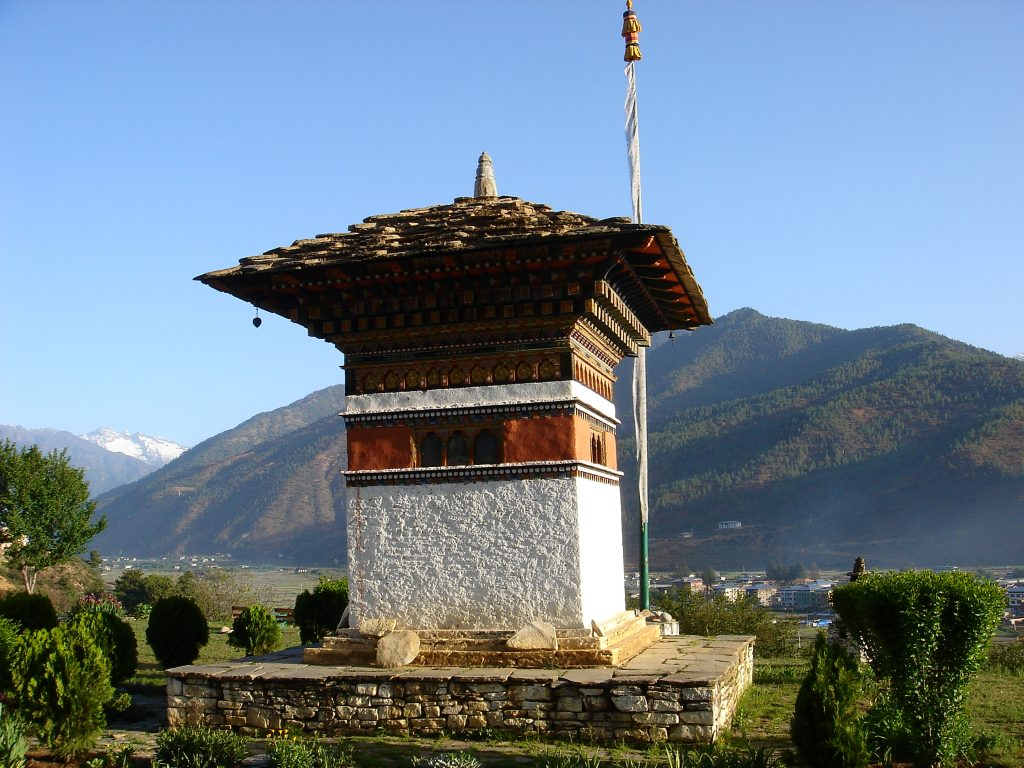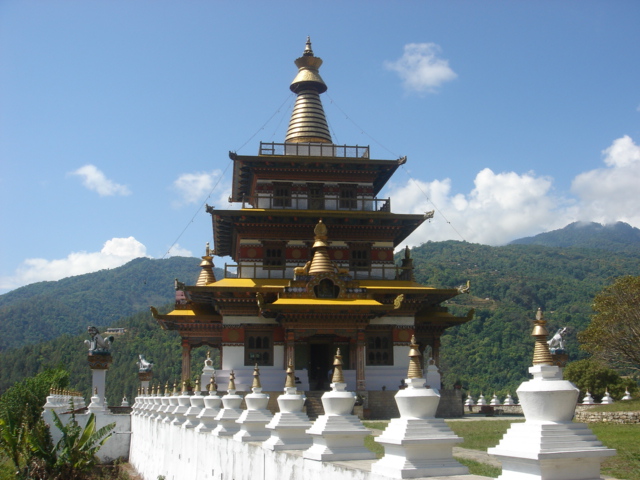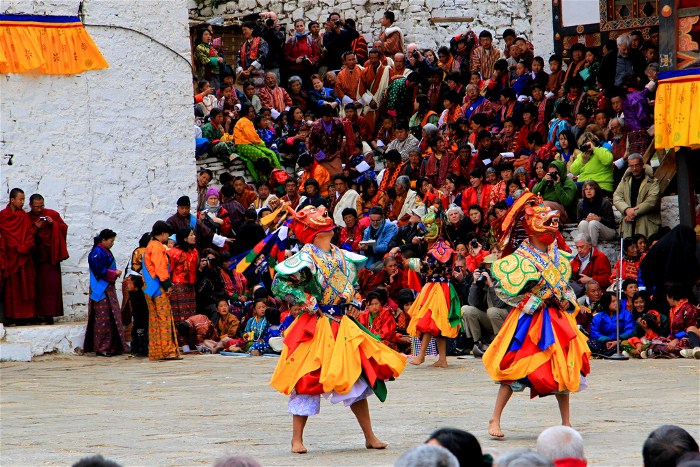


Bhutan
Latest Bhutan (FAQ)
Bhutan, Nestled deep in the eastern Himalayas between India and China with its magnificent mountains dense forest, friendly people pure air, imposing architecture, mystical religion and very interesting arts and culture is certainly a privileged land. The simple pleasure that this country offers gives a sense of kinship with the people love for the land. This pristine beauty of heavenly abode in the mountains make Bhutan a true shangrila, a mythical country exuding charm and casting its spell around those visiting the Kingdom.
The land of dragon is trekker’s paradise and environmentalist dream.
The tiny kingdom of Bhutan shares with Nepal the world’s greatest concentration of mountains and living heritage of Buddhism. Flight to Paro can truly be described as a flight into fantasy. During the flight, a first hand close up view of Mt. Everest, Mt. Kanchenjunga and other famous peaks of the Himalaya range become a reality.
With its beautiful and largely unspoiled Himalayan setting, its rich flora and fauna and its vibrant Buddhist culture, Bhutan has become an increasingly popular destination for international tourists. In addition to generating hard-currency revenue, tourism is also providing impetus for the development of services sector and hence balanced and holistic development of entire region. In an effort to safeguard its rich natural and cultural environment, the country has consciously adopted a controlled tourism and development policy
Clinging to a black rock face, 800 meters above the valley floor, nestles TaktsangLhakhang, one of the holiest sites of Himalayan Buddhism. Such is the sense of peace and serenity as the quiet approach path winds through lush meadow, oak and rhododendron forest, past quaint hamlets, fluttering prayer flags and rotating prayer wheels, and along the precipitous cliff, it is difficult to believe that Bhutan’s only airport is barely kilometers away. Taktsang, the tiger’s lair, acquires its name from the legend of its foundation, when in the 8th Century Guru Rinpoche, widely revered as the second Buddha, arrived from Tibet flying across the mountains on the back of a tigress. He meditated at the site for three months, from where he used the religious cycle of the Kagye to subjugate the Eight Categories of Evil Spirits, and thus converted the region to Buddhism. Over the centuries many luminaries came to meditate at this intensely spiritual place, enriching the legacy of its founding master and strengthening belief in the Buddhist faith.
Frequently Asked Questions (FAQ’s) for tours in Bhutan
Weather in Bhutan
Autumn (Late September to Late November) is the ideal time for trekking and for travelling throughout the country, when skies are generally clear and the high mountain peaks rise to a vivid visible against clear blue sky.
Spring, (Mid March to May), is recognized as the second best time to visit Bhutan for touring and trekking. Although you experience relatively more clouds and rain than in the autumn, you can also get good view of the high Himalayan peaks. The magnificent rhododendrons, magnolias and other wildflowers are in bloom and birdlife is abundant.
The monsoon usually arrives in late June and lasts till mid September. Light to heavy rain expected mainly in evenings and late nights.
Winter (December to early March), the sky is bright and sunny but cold, especially when the sun hides behind the mountains in the mornings and evenings. At night, the temperature falls below zero.
What is the dress code and etiquette to be followed by visitors in Bhutan?
Bhutanese by and large are conservative in their thinking. Please avoid body hugging, sleeveless T shirts or mini skirts while walking around public areas.
No shorts and Tank tops allowed inside the temples, monasteries and Dzongs. Please take off your hats while entering religious sites.
Always walk in a clockwise direction while visiting religious places or objects like temples, monasteries, Stupas (chortens), prayer flags etc. Please do not point a finger at a sacred object or place. It is considered being disrespectful.
What is the accommodation like?
Tourism council of Bhutan (TCB) has now started categorizing hotels into their respective stars. Though some of the hotels are categorized into 4 star or 3 star but the actual service standard doesn’t fully correspond to their star rating. Due to limited availability of skilled manpower in hospitality sector, there is some noticeable flaws in the service at most the mid range hotels (3 STARS).
Specially in major towns (Thimphu, Paro, Punakha, Wangduephodrang, Bumthang & Phuentsholing) hotels are of reasonably good standard however when one ventures into eastern part of the country (Mongar, Trashigang & Samdrup Jongkhar), the lodging gets more rudimentary. Here most of the accommodations are small family run guest houses however at Trashigang couple of decent hotels are under operation now.
Over the past few years a few international opulent hotel chains namely Aman, Taj and COMO have established a few luxury and deluxe hotels & resorts in some of major towns & countryside in Bhutan. These hotels and resorts appropriately maintain international standard of comfort and luxury absolutely blended with local Bhutanese art, culture and tradition.
What kind of vehicles is used for Tours?
We use Hyundai Tucson/ Santa Fe for a group of 1 – 2 guests. A Toyota Hiace mini van for a group of 3 – 6 guests and a deluxe Toyota coaster for a group of 7 – 18 guests. All these vehicles are periodically checked and maintained. These are the only standard tourist vehicles available in Bhutan.
What is the local currency of Bhutan?
Ngultrum is the local currency of Bhutan. Equal in value to the Indian Rupees which is frequently used in place of Ngultrum. Your currency (all major ones like US Dollars, Sterling Pounds, Euros, Indian Rupees etc) and travelers cheque can be exchanged at the Paro Airport, Banks and Hotels. Please note that Nepalese currency and large bills of the Indian currency (Rs. 500 and Rs. 1000) is not accepted in Bhutan.
What is the Time Zone in Bhutan & country code of Bhutan while dialing from Overseas?
Bhutan has only one time zone. It is six hours ahead of Greenwich Mean Time (+6 GMT), half an hour ahead of India (IST) and one hour behind Thailand. Bhutan is eleven hours ahead of New York city.
The country code is 975.
What is the electricity output in Bhutan?
Here, electricity runs on 220 / 240 volts, with a circular two pin and three pin power outlets. For all electrical appliances that you bring with you, please carry the appropriate adapters. Incase you forget, Thimphu is the only city where this may be available.
Is English widely spoken? What is the original language of Bhutan?
Yes, English is widely spoken by an average Bhutanese. It is the medium of instruction in all schools / institutions. However, the official language of Bhutan is Dzongkha, though many regions have retained their dialects due to their isolation.
Money matter and use of credit card & Traveler cheques:
Bhutanese currency is Ngultrum (Nu.) and is officially pegged to the Indian Rupee. Also Indian Rupee is acceptable all over Bhutan except Rs 500 and Rs 1000 currency notes. Credit Cards have limited acceptability and payment through credit card is accepted mainly by Deluxe hotels and few selected Handicrafts establishments only.
There are ATMs in Bhutan but currently they only operate with their respective Bhutanese banks. Since these ATMs currently do not function with outside banks so ATM facility can not be used by visitors. Traveler’s checks / cash are best option if you need additional money.
What kind of food is easily available? Do Vegetarians have enough options?
Bhutanese cuisine generally consists of steamed rice (red and white) with a varied choice of spicy curries, both vegetarian and non vegetarian. Most hotels provide meals buffet style. There are usually continental, Indian, Chinese and Bhutanese dishes. The food in hotels is often the best in town, but in main towns now there are few restaurants increasingly becoming popular. All tourist hotels have good selection of international and Bhutanese beverages. Yes, there are enough options for Vegetarians too.
Any precautions that one must know while traveling in Bhutan.
Yes, your health is of utmost importance to us. Please avoid tap water and stick to Mineral water, easily available everywhere. Roads between cities are winding so medication for motion sickness is strongly suggested. You should also pack an adequate supply of any prescribed medications you may require while traveling.
You should consult a physician about high altitude travel (those taking Punakha/Wangdi or Bumthang tours). After a brief period of acclimatization, most people do not suffer from altitude sickness, but elderly travelers or those with high blood pressure or weak heart conditions need to exercise caution at high altitudes.
What is the baggage allowance on Druk Air?
Druk Air allows 20 kg (44lb) and 30 kg (66 lb) as checked in baggage for its Economy and Business Class Passengers respectively. Excess baggage charged extra.
Do I need to get travel insurance?
Yes, we recommend you get your insurance cover from your respective country.
Please explain the options we have for shopping while we are there?
Bhutan is famous of its exquisite postage stamps, hand woven fabrics, carved masks, woven baskets, wooden bowls, handmade paper, finely crafted metal and Thangkha painting.
Some important notes, do’s and don’ts’
* If there are smokers, they have to declare the cigarettes at the airport and pay 200% tax upon which they will be given a receipt to smoke. Smoking without receipt is illegal in Bhutan now and smoking is not allowed in public areas but designated smoking area. This is a newly enforced rule.
* Apart from the courtyards, guests are not allowed to take pictures inside the monastery, temple, Dzongs and government establishments.
